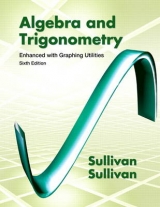
Algebra and Trigonometry Enhanced with Graphing Utilities
Pearson (Verlag)
978-0-13-600492-9 (ISBN)
- Titel erscheint in neuer Auflage
- Artikel merken
Mike Sullivan is a Professor of Mathematics at Chicago State University and received a Ph.D. in mathematics from Illinois Institute of Technology. Mike has taught at Chicago State for over 30 years and has authored or co-authored over fifty books. Mike has four children, all of whom are involved with mathematics or publishing: Kathleen, who teaches college mathematics; Mike III, who co-authors this series and teaches college mathematics; Dan, who is a Pearson Education sales representative; and Colleen, who teaches middle-school mathematics. When he's not writing, Mike enjoys gardening or spending time with his family, including nine grandchildren. Mike Sullivan III is a professor of mathematics at Joliet Junior College. He holds graduate degrees from DePaul University in both mathematics and economics. Mike is an author or co-author on more than 20 books, including a statistics book and a developmental mathematics series. Mike is the father of three children and an avid golfer who tries to spend as much of his limited free time as possible on the golf course.
Chapter R Review
R.1 Real Numbers
R.2 Algebra Essentials
R.3 Geometry Essentials
R.4 Polynomials
R.5 Factoring Polynomials
R.6 Synthetic Division
R.7 Rational Expressions
R.8 nth Roots; Rational Exponents
Chapter 1 Equations and Inequalities
1.1 Rectangular Coordinates; Graphing Utilities; Introduction to Graphing Equations
1.2 Solving Equations Using a Graphing Utility; Linear and Rational Equations
1.3 Quadratic Equations
1.4 Complex Numbers; Quadratic Equations in the Complex Number System
1.5 Radical Equations; Equations Quadratic in Form; Absolute Value Equations; Factorable Equations
1.6 Problem Solving: Interest, Mixture, Uniform Motion, Constant Rate Jobs
1.7 Solving Inequalities
Chapter 2 Graphs
2.1 Symmetry; Graphing Key Equations
2.2 Lines
2.3 Circles
2.4 Variation
Chapter 3 Functions and Their Graphs
3.1 Functions
3.2 The Graph of a Function
3.3 Properties of Functions
3.4 Library of Functions; Piecewise-defined Functions
3.5 Graphing Techniques: Transformations
3.6 Mathematical Models: Building Functions
Chapter 4 Linear and Quadratic Functions
4.1 Linear Functions, Their Properties, and Linear Models
4.2 Building Linear Models from Data; Direct Variation
4.3 Quadratic Functions and Their Properties
4.4 Building Quadratic Models from Verbal Descriptions and Data
4.5 Inequalities Involving Quadratic Functions
Chapter 5 Polynomial and Rational Functions
5.1 Polynomial Functions and Models
5.2 Properties of Rational Functions
5.3 The Graph of a Rational Function; Inverse and Joint Variation
5.4 Polynomial and Rational Inequalities
5.5 The Real Zeros of a Polynomial Function
5.6 Complex Zeros; Fundamental Theorem of Algebra
Chapter 6 Exponential and Logarithmic Functions
6.1 Composite Functions
6.2 One-to-One Functions; Inverse Functions
6.3 Exponential Functions
6.4 Logarithmic Functions
6.5 Properties of Logarithms
6.6 Logarithmic and Exponential Equations
6.7 Financial Models
6.8 Exponential Growth and Decay Models; Newton’s Law; Logistic Growth and Decay Models
6.9 Building Exponential, Logarithmic, and Logistic Models from Data
Chapter 7 Trigonometric Functions
7.1 Angles and Their Measure
7.2 Right Triangle Trigonometry
7.3 Evaluating Trigonometric Functions of Acute Angles
7.4 Evaluating Trigonometric Functions of General Angle
7.5 Unit Circle Approach; Properties of the Trigonometric Functions
7.6 Graphs of the Sine and Cosine Functions
7.7 Graphs of the Tangent, Cotangent, Cosecant, and Secant Functions
7.8 Phase Shift; Building Sinusoidal Models
Chapter 8 Analytic Trigonometry
8.1 The Inverse Sine, Cosine, and Tangent Functions
8.2 The Inverse Trigonometric Functions (Continued)
8.3 Trigonometric Identities
8.4 Sum and Difference Formulas
8.5 Double-angle and Half-angle Formulas
8.6 Product-to-Sum and Sum-to-Product Formulas
8.7 Trigonometric Equations (I)
8.8 Trigonometric Equations (II)
Chapter 9 Applications of Trigonometric Functions
9.1 Applications Involving Right Triangles
9.2 The Law of Sines
9.3 The Law of Cosines
9.4 Area of a Triangle
9.5 Simple Harmonic Motion; Damped Motion; Combining Waves
Chapter 10 Polar Coordinates; Vectors
10.1 Polar Coordinates
10.2 Polar Equations and Graphs
10.3 The Complex Plane; De Moivre’s Theorem
10.4 Vectors
10.5 The Dot Product
Chapter 11 Analytic Geometry
11.1 Conics
11.2 The Parabola
11.3 The Ellipse
11.4 The Hyperbola
11.5 Rotation of Axes; General Form of a Conic
11.6 Polar Equations of Conics
11.7 Plane Curves and Parametric Equations
Chapter 12 Systems of Equations and Inequalities
12.1 Systems of Linear Equations: Substitution and Elimination
12.2 Systems of Linear Equations: Matrices
12.3 Systems of Linear Equations: Determinants
12.4 Matrix Algebra
12.5 Partial Fraction Decomposition
12.6 Systems of Nonlinear Equations
12.7 Systems of Inequalities
12.8 Linear Programming
Chapter 13 Sequences; Induction; the Binomial Theorem
13.1 Sequences
13.2 Arithmetic Sequences
13.3 Geometric Sequences; Geometric Series
13.4 Mathematical Induction
13.5 The Binomial Theorem
Chapter 14 Counting and Probability
14.1 Counting
14.2 Permutations and Combinations
14.3 Probability
| Erscheint lt. Verlag | 7.12.2007 |
|---|---|
| Sprache | englisch |
| Maße | 216 x 279 mm |
| Gewicht | 2463 g |
| Themenwelt | Mathematik / Informatik ► Mathematik ► Algebra |
| Mathematik / Informatik ► Mathematik ► Geometrie / Topologie | |
| ISBN-10 | 0-13-600492-X / 013600492X |
| ISBN-13 | 978-0-13-600492-9 / 9780136004929 |
| Zustand | Neuware |
| Haben Sie eine Frage zum Produkt? |
aus dem Bereich



